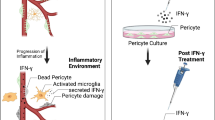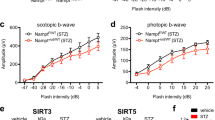Abstract
In this study, the role of CX3CR1 in the progression of diabetic retinopathy (DR) was investigated. The retinas of wild-type (WT), CX3CR1 null (CX3CR1gfp/gfp, KO), and heterozygous (CX3CR1+/gfp, Het) mice were compared in the presence and absence of streptozotocin (STZ)-induced diabetes. CX3CR1 deficiency in STZ-KO increased vascular pathology at 4 months of diabetes, as a significant increase in acellular capillaries was observed only in the STZ-KO group. CX3CR1 deficiency and diabetes had similar effects on retinal neurodegeneration measured by an increase in DNA fragmentation. Retinal vascular pathology in STZ-KO mice was associated with increased numbers of monocyte-derived macrophages in the retina. Furthermore, compared to STZ-WT, STZ-KO mice exhibited increased numbers of inflammatory monocytes in the bone marrow and impaired homing of monocytes to the spleen. The induction of retinal IL-10 expression by diabetes was significantly less in KO mice, and when bone marrow-derived macrophages from KO mice were maintained in high glucose, they expressed significantly less IL-10 and more TNF-α in response to LPS stimulation. These findings support that CX3CR1 deficiency accelerates the development of vascular pathology in DR through increased recruitment of proinflammatory myeloid cells that demonstrate reduced expression of anti-inflammatory IL-10.
Key messages
• CX3CR1 deletion in STZ-diabetic mice accelerated the onset of diabetic retinopathy (DR).
• The early onset of DR was associated with increased retinal cell apoptosis.
• The early onset of DR was associated with increased recruitment of bone marrow-derived macrophages to the retina.
• Bone marrow-derived macrophages from CX3CR1 KO diabetic mice expressed more TNF-α and less IL-10.
• The role of IL-10 in protection from progression of DR is highlighted.







Similar content being viewed by others
References
Fong DS, Aiello L, Gardner TW, King GL, Blankenship G, Cavallerano JD, Ferris FL 3rd, Klein R, American Diabetes A (2003) Diabetic retinopathy. Diabetes Care 26(Suppl 1):S99–S102
Simo R, Hernandez C (2015) ç. Prog Retin Eye Res 48:160-180. doi:10.1016/j.preteyeres.2015.04.003
Barber AJ, Gardner TW, Abcouwer SF (2011) The significance of vascular and neural apoptosis to the pathology of diabetic retinopathy. Invest Ophthalmol Vis Sci 52(2):1156–1163
Tang J, Kern TS (2011) Inflammation in diabetic retinopathy. Prog Retin Eye Res 30(5):343–358
Grigsby JG, Cardona SM, Pouw CE, Muniz A, Mendiola AS, Tsin AT, Allen DM, Cardona AE (2014) The role of microglia in diabetic retinopathy. J Ophthalmol 2014:705783
Martin PM, Roon P, Van Ells TK, Ganapathy V, Smith SB (2004) Death of retinal neurons in streptozotocin-induced diabetic mice. Invest Ophthalmol Vis Sci 45(9):3330–3336
Sasaki M, Ozawa Y, Kurihara T, Kubota S, Yuki K, Noda K, Kobayashi S, Ishida S, Tsubota K (2010) Neurodegenerative influence of oxidative stress in the retina of a murine model of diabetes. Diabetologia 53(5):971–979
Yang Y, Mao D, Chen X, Zhao L, Tian Q, Liu C, Zhou BL (2012) Decrease in retinal neuronal cells in streptozotocin-induced diabetic mice. Mol Vis 18:1411–1420
Kern TS, Tang J, Berkowitz BA (2010) Validation of structural and functional lesions of diabetic retinopathy in mice. Mol Vis 16:2121–2131
Cherry JD, Olschowka JA, O'Banion MK (2014) Neuroinflammation and M2 microglia: the good, the bad, and the inflamed. J Neuroinflammation 11:98
Schwartz M, Baruch K (2014) The resolution of neuroinflammation in neurodegeneration: leukocyte recruitment via the choroid plexus. EMBO J 33(1):7–22
Imai T, Hieshima K, Haskell C, Baba M, Nagira M, Nishimura M, Kakizaki M, Takagi S, Nomiyama H, Schall TJ et al (1997) Identification and molecular characterization of fractalkine receptor CX3CR1, which mediates both leukocyte migration and adhesion. Cell 91(4):521–530
Foussat A, Coulomb-L'Hermine A, Gosling J, Krzysiek R, Durand-Gasselin I, Schall T, Balian A, Richard Y, Galanaud P, Emilie D (2000) Fractalkine receptor expression by T lymphocyte subpopulations and in vivo production of fractalkine in human. Eur J Immunol 30(1):87–97
Thomas G, Tacke R, Hedrick CC, Hanna RN (2015) Nonclassical patrolling monocyte function in the vasculature. Arterioscler Thromb Vasc Biol 35(6):1306–1316
Chakravarthy H, Beli E, Navitskaya S, O'Reilly S, Wang Q, Kady N, Huang C, Grant MB, Busik JV (2016) Imbalances in mobilization and activation of pro-inflammatory and vascular reparative bone marrow-derived cells in diabetic retinopathy. PLoS One 11(1):e0146829
Chakravarthy H, Navitskaya S, O'Reilly S, Gallimore J, Mize H, Beli E, Wang Q, Kady N, Huang C, Blanchard GJ, Grant MB, Busik JV (2015) Role of acid sphingomyelinase in shifting the balance between pro-inflammatory and reparative bone marrow cells in diabetic retinopathy. Stem cells. doi:10.1002/stem.2259
Hazra S, Jarajapu YP, Stepps V, Caballero S, Thinschmidt JS, Sautina L, Bengtsson N, Licalzi S, Dominguez J, Kern TS et al (2013) Long-term type 1 diabetes influences haematopoietic stem cells by reducing vascular repair potential and increasing inflammatory monocyte generation in a murine model. Diabetologia 56(3):644–653
Hu P, Thinschmidt JS, Yan Y, Hazra S, Bhatwadekar A, Caballero S, Salazar T, Miyan JA, Li W, Derbenev A et al (2013) CNS inflammation and bone marrow neuropathy in type 1 diabetes. Am J Pathol 183(5):1608–1620
Yellowlees Douglas J, Bhatwadekar AD, Li Calzi S, Shaw LC, Carnegie D, Caballero S, Li Q, Stitt AW, Raizada MK, Grant MB (2012) Bone marrow-CNS connections: implications in the pathogenesis of diabetic retinopathy. Prog Retin Eye Res 31(5):481–494
Cardona AE, Pioro EP, Sasse ME, Kostenko V, Cardona SM, Dijkstra IM, Huang D, Kidd G, Dombrowski S, Dutta R et al (2006) Control of microglial neurotoxicity by the fractalkine receptor. Nat Neurosci 9(7):917–924
Wolf Y, Yona S, Kim KW, Jung S (2013) Microglia, seen from the CX3CR1 angle. Front Cell Neurosci 7:26
Paolicelli RC, Bisht K, Tremblay ME (2014) Fractalkine regulation of microglial physiology and consequences on the brain and behavior. Front Cell Neurosci 8:129
Zieger M, Ahnelt PK, Uhrin P (2014) CX3CL1 (fractalkine) protein expression in normal and degenerating mouse retina: in vivo studies. PLoS One 9(9):e106562
Liang KJ, Lee JE, Wang YD, Ma W, Fontainhas AM, Fariss RN, Wong WT (2009) Regulation of dynamic behavior of retinal microglia by CX3CR1 signaling. Invest Ophthalmol Vis Sci 50(9):4444–4451
Raoul W, Feumi C, Keller N, Lavalette S, Houssier M, Behar-Cohen F, Combadiere C, Sennlaub F (2008) Lipid-bloated subretinal microglial cells are at the origin of drusen appearance in CX3CR1-deficient mice. Ophthalmic Res 40(3-4):115–119
Lu P, Li L, Kuno K, Wu Y, Baba T, Li YY, Zhang X, Mukaida N (2008) Protective roles of the fractalkine/CX3CL1-CX3CR1 interactions in alkali-induced corneal neovascularization through enhanced antiangiogenic factor expression. J Immunol 180(6):4283–4291
Moatti D, Faure S, Fumeron F, Amara Mel W, Seknadji P, McDermott DH, Debre P, Aumont MC, Murphy PM, de Prost D et al (2001) Polymorphism in the fractalkine receptor CX3CR1 as a genetic risk factor for coronary artery disease. Blood 97(7):1925–1928
Kasama T, Wakabayashi K, Sato M, Takahashi R, Isozaki T (2010) Relevance of the CX3CL1/fractalkine-CX3CR1 pathway in vasculitis and vasculopathy. Transl Res J Lab Clin Med 155(1):20–26
Lauro C, Catalano M, Trettel F, Limatola C (2015) Fractalkine in the nervous system: neuroprotective or neurotoxic molecule? Annals of the New York Academy of Sciences. doi:10.1111/nyas.12805
Serra AM, Waddell J, Manivannan A, Xu H, Cotter M, Forrester JV (2012) CD11b + bone marrow-derived monocytes are the major leukocyte subset responsible for retinal capillary leukostasis in experimental diabetes in mouse and express high levels of CCR5 in the circulation. Am J Pathol 181(2):719–727
Rangasamy S, McGuire PG, Franco Nitta C, Monickaraj F, Oruganti SR, Das A (2014) Chemokine mediated monocyte trafficking into the retina: role of inflammation in alteration of the blood-retinal barrier in diabetic retinopathy. PLoS One 9(10):e108508
Cardona SM, Mendiola AS, Yang YC, Adkins SL, Torres V, Cardona AE (2015) Disruption of Fractalkine signaling leads to microglial activation and neuronal damage in the diabetic retina. ASN neuro 7 (5). doi:10.1177/1759091415608204
Kezic JM, Chen X, Rakoczy EP, McMenamin PG (2013) The effects of age and Cx3cr1 deficiency on retinal microglia in the Ins2(Akita) diabetic mouse. Invest Ophthalmol Vis Sci 54(1):854–863
Bhatwadekar A, Glenn JV, Figarola JL, Scott S, Gardiner TA, Rahbar S, Stitt AW (2008) A new advanced glycation inhibitor, LR-90, prevents experimental diabetic retinopathy in rats. Br J Ophthalmol 92(4):545–547
O'Koren EG, Mathew R, Saban DR (2016) Fate mapping reveals that microglia and recruited monocyte-derived macrophages are definitively distinguishable by phenotype in the retina. Sci Rep 6:20636
Abcouwer SF, Lin CM, Wolpert EB, Shanmugam S, Schaefer EW, Freeman WM, Barber AJ, Antonetti DA (2010) Effects of ischemic preconditioning and bevacizumab on apoptosis and vascular permeability following retinal ischemia-reperfusion injury. Invest Ophthalmol Vis Sci 51(11):5920–5933
Jung S, Aliberti J, Graemmel P, Sunshine MJ, Kreutzberg GW, Sher A, Littman DR (2000) Analysis of fractalkine receptor CX(3)CR1 function by targeted deletion and green fluorescent protein reporter gene insertion. Mol Cell Biol 20(11):4106–4114
Hu SJ, Calippe B, Lavalette S, Roubeix C, Montassar F, Housset M, Levy O, Delarasse C, Paques M, Sahel JA et al (2015) Upregulation of P2RX7 in Cx3cr1-deficient mononuclear phagocytes leads to increased interleukin-1beta secretion and photoreceptor neurodegeneration. J Neurosci Off J Soc Neurosci 35(18):6987–6996
Karlmark KR, Zimmermann HW, Roderburg C, Gassler N, Wasmuth HE, Luedde T, Trautwein C, Tacke F (2010) The fractalkine receptor CX(3)CR1 protects against liver fibrosis by controlling differentiation and survival of infiltrating hepatic monocytes. Hepatology 52(5):1769–1782
Sennlaub F, Auvynet C, Calippe B, Lavalette S, Poupel L, Hu SJ, Dominguez E, Camelo S, Levy O, Guyon E et al (2013) CCR2(+) monocytes infiltrate atrophic lesions in age-related macular disease and mediate photoreceptor degeneration in experimental subretinal inflammation in Cx3cr1 deficient mice. EMBO Mol Med 5(11):1775–1793
Raoul W, Keller N, Rodero M, Behar-Cohen F, Sennlaub F, Combadiere C (2008) Role of the chemokine receptor CX3CR1 in the mobilization of phagocytic retinal microglial cells. J Neuroimmunol 198(1-2):56–61
Combadiere C, Feumi C, Raoul W, Keller N, Rodero M, Pezard A, Lavalette S, Houssier M, Jonet L, Picard E et al (2007) CX3CR1-dependent subretinal microglia cell accumulation is associated with cardinal features of age-related macular degeneration. J Clin Invest 117(10):2920–2928
Chinnery HR, McLenachan S, Humphries T, Kezic JM, Chen X, Ruitenberg MJ, McMenamin PG (2012) Accumulation of murine subretinal macrophages: effects of age, pigmentation and CX3CR1. Neurobiol Aging 33(8):1769–1776
Nakazawa T, Hisatomi T, Nakazawa C, Noda K, Maruyama K, She H, Matsubara A, Miyahara S, Nakao S, Yin Y et al (2007) Monocyte chemoattractant protein 1 mediates retinal detachment-induced photoreceptor apoptosis. Proc Natl Acad Sci U S A 104(7):2425–2430
Caballero S, Hazra S, Bhatwadekar A, Li Calzi S, Paradiso LJ, Miller LP, Chang LJ, Kern TS, Grant MB (2013) Circulating mononuclear progenitor cells: differential roles for subpopulations in repair of retinal vascular injury. Invest Ophthalmol Vis Sci 54(4):3000–3009
Fadini GP, de Kreutzenberg SV, Boscaro E, Albiero M, Cappellari R, Krankel N, Landmesser U, Toniolo A, Bolego C, Cignarella A et al (2013) An unbalanced monocyte polarisation in peripheral blood and bone marrow of patients with type 2 diabetes has an impact on microangiopathy. Diabetologia 56(8):1856–1866
Acknowledgments
The authors would like to thank Neal Benson from the cytometry core at the ICBR in University of Florida. Research was supported by NIH grants: EY012601-15, EY007739-25, EY018358, EY023629 (MB), DK 090730 and HL110170 (MBG).
Author information
Authors and Affiliations
Corresponding author
Additional information
Eleni Beli and James M. Dominguez II contributed equally to this work.
An erratum to this article is available at http://dx.doi.org/10.1007/s00109-017-1530-8.
Electronic supplementary material
Below is the link to the electronic supplementary material.
ESM 1
Supplemental Figure S1: Gating strategy for single cell suspension of brain and retina. Viable/Live singlets were gated on, CD45+, CD45hi recruits, and then F4/80+/- Ly6G- mononuclear cells. Using this gating strategy allowed subsequent analysis of Ly6C+ monocytes and Ly6C- monocyte/macrophage. Data shown are from brain and retina of STZ-diabetic WT mice. Supplemental Figure S2: Gating strategy for single cell suspension of bone marrow and spleen. Splenic and bone marrow monocytes were gated in the lymphocyte gate based on forward and side scatter and identified as Lineage 1 (CD3e, CD19, NK1.1, Ly6G) negative, Lineage 2 (CD11c, F4/80, IA-b) negative and CD11b+ cells (PPTX 379 kb)
Rights and permissions
About this article
Cite this article
Beli, E., Dominguez, J.M., Hu, P. et al. CX3CR1 deficiency accelerates the development of retinopathy in a rodent model of type 1 diabetes. J Mol Med 94, 1255–1265 (2016). https://doi.org/10.1007/s00109-016-1433-0
Received:
Revised:
Accepted:
Published:
Issue Date:
DOI: https://doi.org/10.1007/s00109-016-1433-0




